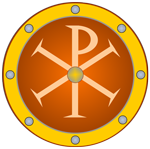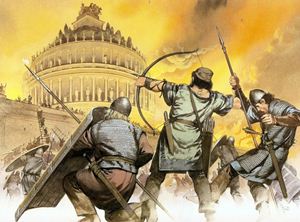
First Siege of Rome |
year: 537-5381/3/537 - 12/3/538 |
| Ineffective siege of Byzantine-occupied Rome by the Ostrogoths | ★ ★ ★ ★ ★ |
|
enemy: Ostrogoths
|
location: Rome, Italy
|
accuracy:
●●●●●
|
|
battle type: Siege |
war: Gothic War in Italy |
modern country:
Italy |
| ▼ The Byzantines(emperor: Justinian I) | ▼ The Enemies | |
| Commander: | General Belisarius | King Vitiges |
| Forces: | 5,000 (+5,600 reinforcements later) | c. 45,000 |
| Losses: |
| Background story: |
| After the fast overthrow of the kingdom of the Vandals in North Africa, Emperor Justinian decided to attack the kingdom of the Ostrogoths in Italy on the pretext of the imprisonment and assassination of the queen of the Ostrogoths Amalaswintha by her cousin and co-ruler king Theodahad (or Theodatus). Thus, at the beginning of 535, Byzantine forces invaded Italy. Belisarius attacked Sicily with a fleet of 8,000 men, while magister militum per Illyricum Mundus from Dalmatia invaded northern Italy with 4,000 men. Belisarius conquered Sicily within a few months and then moved north. He met serious resistance in Naples, which he captured after a difficult siege in November 536. The fall of Naples sparked a crisis for the Ostrogoths who dethroned Theodatus. The old general Vitiges became the new king of the Ostrogoths. Belisarius continued his advance and arrived in Rome. After brief negotiations, on December 9, 536, the Eternal City opened its gates and the Byzantine army entered the city through the “Porta Asinaria” on the SE side of the walls, at the same time that the Gothic guard was leaving from the north gate of “Porta Flaminia” to the antidiametric point of the city. Belisarios, having a small army now, did not consider it wise to continue the march towards Ravenna. So he stayed in Rome, but he did not rest and began to prepare from the first day for a siege, knowing well that the Goths would return very soon. To defend Rome, Belisarius had less than 5,000 men, as the rest of his troops manned guards in Sicily and southern Italy. |
The Battle: |
 Siege of Rome 537 Rome's defense was well organized, although Belisarius, as usual, was not content with a passive defense. Every now and then he would harass the besiegers with quick and sudden exits. In this way he never let his enemies rest, in addition managing to keep maritime communications open for a long time. Due to the large size of the city, the Goths did not completely encircle it, but set up seven fortified camps, one opposite each of the main gates of Rome. The besiegers destroyed the numerous aqueducts that brought water to the city (which served the city for centuries and the damage done then was never repaired). At the beginning of the siege, the Goths attempted large-scale attacks using impressive siege engines, but these attacks were effectively repulsed by the Byzantines. The Goths, despite the strong resistance of the besieged and the fact that they suffered from epidemics, constantly tightened the siege, and when they managed to blockade Rome by sea as well, the besieged found themselves in a very difficult position. The inhabitants began to suffer and seemed remorseful that they had consented to the surrender of the city to Belisarius. The generalized discomfort was expressed mainly by the senators and the nobles. Several were imprisoned. Among them was Pope Silverius who was deposed and exiled to the East, as a suspect of cooperation with the Goths. The coveted aid, about 5,600, arrived in November of the following year. Belisarius now had the opportunity to take bolder action. With continuous raids on the rear of the Goths, it hit their supply lines, even occupying some cities and strongholds at key points. So the Goths were converted from besiegers to besieged, and in March 538, after a year and nine days, they lifted the siege, and headed north. Belisarius pursued them and after waiting for half the enemy army to cross the Milvian bridge, attacked the part that was left behind. A great massacre of the Goths followed, while many of them drowned in the river. |
Noteworthy: |
| The Gothic Wars, and in particular this siege, had a disastrous effect on the city. By one estimate the population declined by 90% to around 30,000 by the year 550. Of the original 13 aqueducts (that secured also the operation of watermills and, thus, the food supply) only 2 remained functional, and the populated area dropped to 10% of that at its peak. |
Aftermath: |
| After the victory, the Romans gained the upper hand. Reinforcements under Narses arrived, which enabled Belisarius to take control of most of Italy south of the River Po by 539. The successes continued until 540, when leader of the Ostrogoths became Totila, who, taking advantage of the departure of Belisarius, managed to reverse the situation and recapture most of the territories in Northern Italy. Rome was besieged again in 546 and this time was taken by the Ostrogoths. |
|
|
